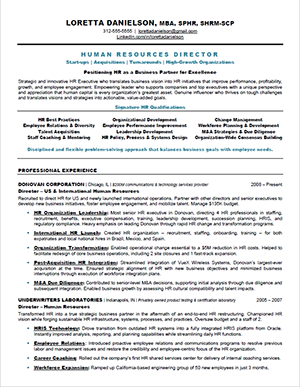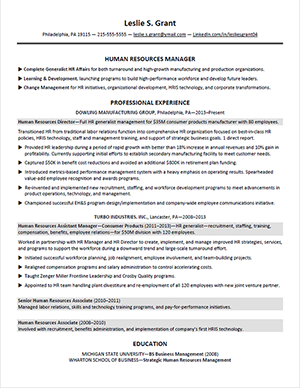How to Write Powerful and Memorable HR Resumes-Employee Development
7 rules to guide you through showcasing your talents and accomplishments

No matter how many hundreds, or even thousands, of resumes you've reviewed throughout your HR career, writing your own resume is always a challenge. It can be difficult to take a step back and look at your career objectively to identify what makes you uniquely qualified and distinctive from other candidates. Why are people going to remember you? Why will people want to hire you? What is your unique value to a new employer?
The answers to those questions and many others should be the foundation upon which you build your resume and brand yourself for new professional opportunities.
While there's no formula or single template to use in crafting an HR resume, there are certain guidelines that will help you write, format and design a resume that will showcase your greatest talents, accomplishments and value to a potential new employer. These seven "rules of the resume road" are applicable to all HR professionals, managers and executives.
1. Use a Well-Branded Headline
Of course, your resume will start with your name and contact information (phone number and live links to both your e-mail address and LinkedIn profile) prominently positioned at the top of the page. Immediately following that, include a headline statement that tells readers “who” you are professionally in regard to your current career objective. With just a quick glance, readers instantly recognize that you’re an HR generalist, an employee and benefits specialist, or a senior HR and organizational development executive.
Your headline statement replaces the now outdated “Career Summary” or “Professional Profile” heading that you may have used in the past to begin the summary section of your resume. Those headings don’t communicate any information, while your headline instantly does.
After you’ve written your headline, think about adding one or two subheadings to further define your expertise. Do you have an industry specialization? Any distinguishing credentials? Experience with a hot-button HR issue? With just a few words, you can quickly convey relevant and valuable information about yourself that will set you apart from other candidates.
In the two sample resumes that accompany this article, you’ll immediately notice the relevant headlines: “Human Resources Manager” for Leslie Grant, followed by three short, bulleted statements that summarize her key areas of expertise. (The resumes are both linked to each person’s name, and appear at the end of the article.)
For Loretta Danielson, we’ve used a three-line headline. The first line, “Human Resources Director,” positions her for the level of job she’s targeting; the second line communicates the breadth of her experience, from startups to high-growth organizations; and the third line, “Positioning HR as a Business Partner for Excellence,” is what we refer to as a branding statement, her unique value proposition.
One word of caution about headlines—and, in fact, about everything that you include in your resume. Be certain that what you are highlighting matches not only what you’ve done in the past but also what you want to do in the future. This is extremely important because you want readers to perceive you as a qualified and experienced candidate for the positions you’re currently targeting.
If you have extensive experience managing compensation and benefits, for example, but you don’t want that to be a major part of your next job, don’t highlight it with a headline. You can mention it as appropriate in the experience section, but don’t make the mistake of drawing attention to something you don’t want readers to focus on. Be selective and be strategic.
2. Share Details About the Organizations Where You’ve Worked
Help your readers understand the depth and breadth of your experience by providing details about the organizations where you’ve worked. You can cite the number of employees, the number of locations, the total annual company revenue, the specific business or industry, and other details that will give readers a frame of reference.
You’ll notice brief company descriptions on both of the resume samples we’re sharing. On Leslie’s resume, the information is integrated into the short paragraph immediately under each company’s name. On Loretta’s resume, the information is positioned right next to the company name.
No matter where you position the information, it’s valuable. Knowing where you’ve worked helps readers put everything into context and makes your experience and accomplishments all that more impressive.
Just as with your headline, be strategic. If you’ve worked only at very large public companies and now want to move to a small privately held business, the size of those companies might scare off your target employers. Think about your goals and add the details that make you a good fit for the companies, associations and/or other organizations where you want to work.
3. Emphasize Achievements
This is perhaps the most critical strategy in creating a powerful and memorable resume. Without specific achievements, your resume will sound much like that of any other HR professional who has similar experience.
While your knowledge and expertise are important, hiring managers want to know more. They want to know what you have done—how you have contributed to business objectives, how you have made a difference, what measurable results you have produced, how you’ve strengthened the HR organization, what you’ve done to improve company culture and more.
In the accompanying sample resumes, you will see both quantified and unquantified achievement bullets. It’s important to realize that both add value to the resume, so don’t feel that you must have a number or hard result for every bullet point.
In fact, HR professionals sometimes find it difficult to quantify achievements. After all, HR is not sales. But we encourage you to dig deep to find results wherever possible. Often if you ask yourself about the problem you solved—not just the activity, but why that activity was important to the business—you can find positive and perhaps measurable outcomes.
4. Highlight HR Keywords
You know how important keywords are for both human readers and electronic eyes scanning your resume. If you don’t include those all-important terms, you may be perceived as unqualified and your resume may be passed over. Don’t let that happen to you!
Look for opportunities to introduce keywords throughout your resume. You can create a “Core Competencies” or “Professional Skills Summary” at the top, but that’s not enough. You want keywords to be prevalent throughout every section of your resume.
Look at Leslie’s resume. When you read her Professional Experience section, you find a wealth of HR keywords in every sentence. What’s more, her resume isn’t loaded with lengthy “responsible for” statements. Rather, the keywords are seamlessly integrated into all of her achievement bullets so that readers gain clear and compelling evidence of her HR activities, expertise and value.
Next, look at Loretta’s resume. One of the first things you notice in the Professional Experience section are the bold keywords at the start of each bullet point. This is a very effective strategy both for increasing the keyword density of your resume and for making your resume highly “skimmable.” Readers immediately gain a sense of your expertise from a quick keyword scan, setting you apart from the competition.
5. Prepare Your Resume for Applicant Tracking Systems
Carrying on with our discussion of the importance of keywords … as an HR professional you have an advantage over most candidates. You have the opportunity to look “under the hood” of an applicant tracking system (ATS) to see what happens in a typical keyword-driven resume review. Use that knowledge for your own benefit.
Because there are so many ATSs, and because candidate searches are conducted by humans who have their own habits and preferences, you can’t guarantee a perfect result from every ATS scan. But you can—and should—follow best practices for formatting your resume, integrating keywords and increasing keyword density.
For example, in Loretta’s resume you’ll note that the acronyms after her name are later spelled out fully in the appropriate section of the resume. “SHRM-SCP” becomes “Society for Human Resource Management Senior Certified Professional” under the Education & Professional Credentials section. This gives her a greater chance of being found in a computerized keyword scan, regardless of the exact term the hiring manager inputs for a specific search.
6. Share What Makes You Special
Obviously, your professional experience and educational credentials are vital in positioning you as a well-qualified candidate. However, there are many other items you can—and should—include in your resume if relevant to your career. These items add further value, distinction and qualification.
Be certain to include any of these that are relevant to you: Professional credentials (e.g., SHRM-SCP); professional affiliations (e.g., SHRM, OD Network); board of director appointments and other leadership posts; presentations and public speaking engagements; media features and quotes; and publications.
We recommend that you focus the above on professional activities and exclude common civic and/or community-based affiliations. Resume “real estate”—just one or two pages—is extremely valuable, so you want to be certain that each line of text adds strength to your candidacy.
7. Write Tight, Lean and Clean
Clean, clear, concise writing is the hallmark of a powerful and modern resume. Readers simply don’t have the time or inclination to wade through irrelevant experiences, fluffy adjectives, unnecessary details and other “filler” that weighs down many resumes.
No one writes tight, lean and clean on the first pass. It requires repeated review, careful editing, and a constant focus on strategy and goals to determine what’s important to include and what does not support your professional brand and your current career objectives.
In addition to tight writing, pay attention to how your resume is formatted. Avoid dense paragraphs (anything longer than three or four lines) and allow ample white space to create an inviting document that rewards readers, whether they come for a quick skim or a more thorough read.
Moving Forward
These seven guidelines to writing powerful, impactful and memorable HR resumes cover just some of the many things you can do to create a resume that will work for you and distinguish you from the crowd of other applicants, many of whom are also well-qualified. Constantly remind yourself that you’re writing to the future—to the positions that you’re targeting—and emphasize the relevant skills, experiences, achievements, keywords and results.
If you can focus on what matters most, showcase what’s unique about you and your career, and design a resume that’s sharp and distinctive, chances are you will get noticed, you will get interviewed and, we hope, you will get hired.
Wendy Enelow and Louise Kursmark are both Master Resume Writers (MRW), Job & Career Transition Coaches (JCTC), and Certified Professional Resume Writers (CPRW). Separately and together, they have authored 40-plus books on resumes, cover letters, keywords and career management, including the recently released Modernize Your Resume: Get Noticed … Get Hired (Emerald Career Publishing, 2016) (www.emeraldcareerpublishing.com). Reach them by e-mail at wendy@wendyenelow.com or louise@louisekursmark.com.
Resume Samples
An organization run by AI is not a futuristic concept. Such technology is already a part of many workplaces and will continue to shape the labor market and HR. Here's how employers and employees can successfully manage generative AI and other AI-powered systems.
 Resume Sample #1 (PDF)
Resume Sample #1 (PDF)




